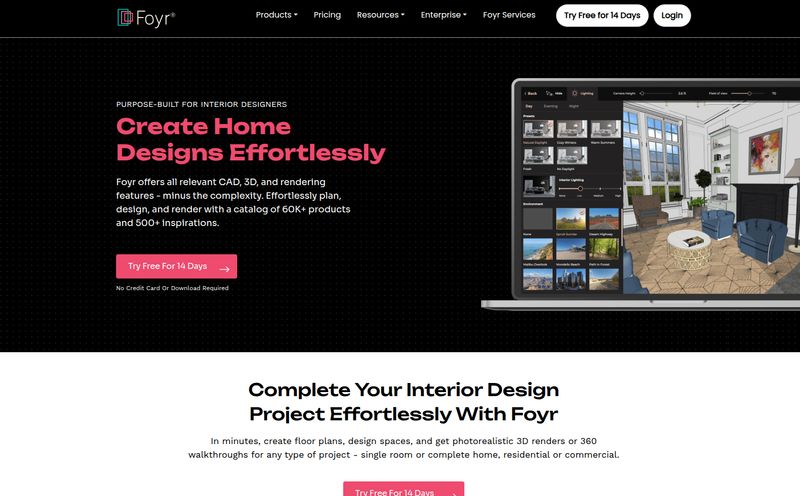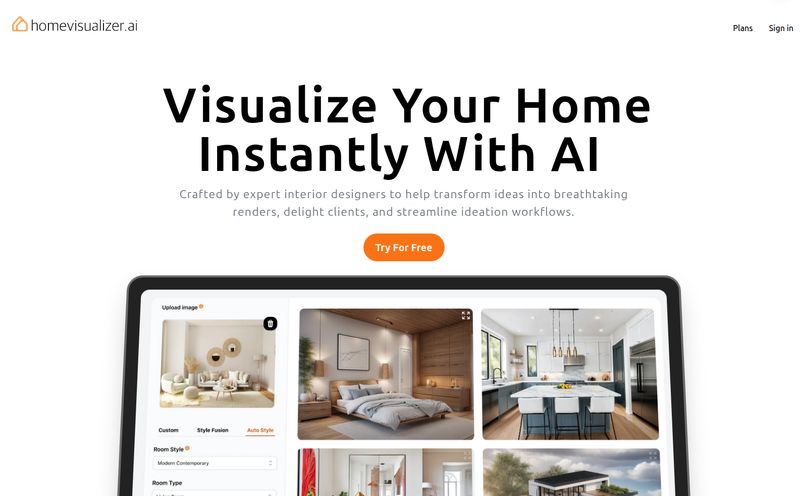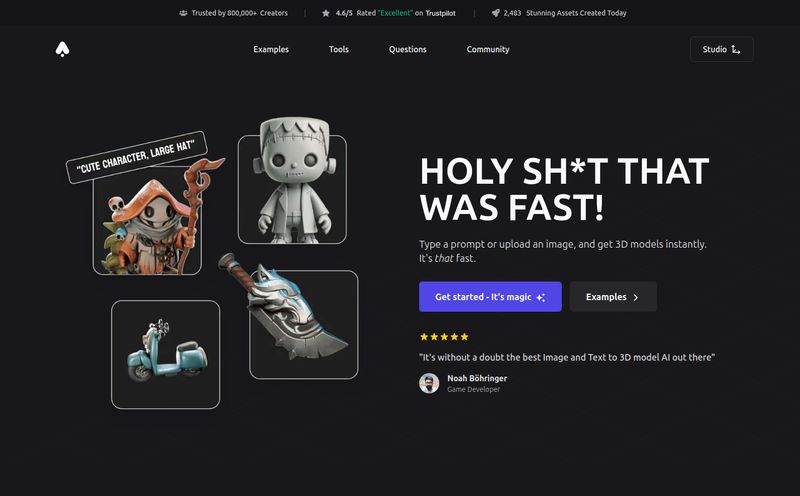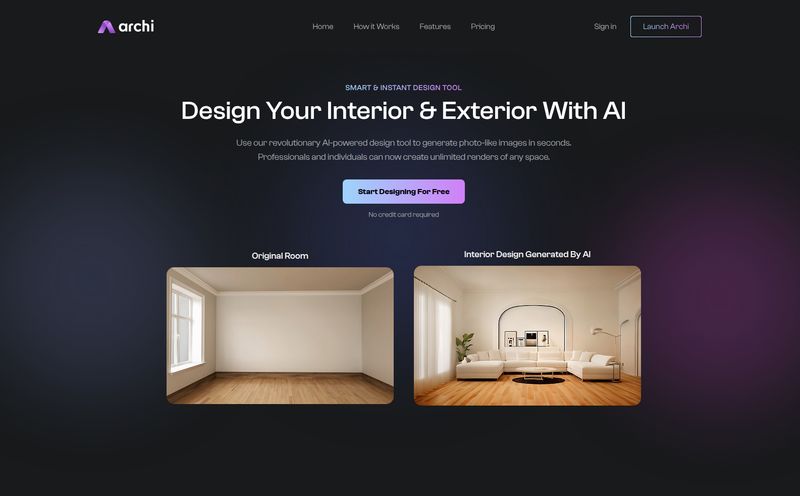I’ve been in the SEO and digital creation space for years, and if there’s one thing that’s always felt like pulling teeth, it’s 3D modeling. I've spent more hours than I’d like to admit wrestling with clunky, unintuitive software that feels like it was designed by engineers for, well, other engineers. The learning curves are steep, the interfaces are crowded, and half the time you just want to sketch out a quick idea, not build a digital twin for NASA. So, when I first heard about Arcadium, an AI-powered online 3D house design tool, my professional curiosity was piqued, but my inner skeptic was on high alert.
Another tool promising to “revolutionize” design? Sure. But this one felt a bit different. No download. No installation. Just open a browser and… start building. I had to see for myself.
So, What is Arcadium, Really?
Let's get this out of the way: Arcadium is an online platform for creating 3D floor plans and interior designs. But that’s a boring description. What it feels like is something else entirely. The best way I can put it? It’s like playing Minecraft, but for adults who need to design actual houses.
You’re not bogged down in a million menus and technical settings. You draw walls, you drop in furniture from a library, you move things around. It's blocky, it's intuitive, and it’s fast. Ridiculously fast. The goal here isn't to replace hyper-detailed programs like Revit or AutoCAD for construction documents. Not at all. The goal is ideation, communication, and visualization. It’s for getting that brilliant idea out of your head and into a format someone else can see—and walk through—in a matter of minutes, not days.
My First 30 Minutes with Arcadium: A Quick Walkthrough
Signing up was free and took about 30 seconds. No credit card, no funny business. Once I was in, I was staring at a clean, grid-lined canvas. It felt… approachable. I decided to try and recreate my own living room. I started drawing walls, and they snapped together satisfyingly. I found the door tool, clicked, and a door appeared. Same with windows.
But the real magic happened when I started furnishing the place. The built-in 3D model library is pretty extensive. I found a sofa that looked close enough to mine, a coffee table, and a TV stand. Everything is scale-accurate, so you get a real sense of space. The controls are simple: click, drag, rotate. The auto-alignment and snapping tools mean you’re not spending ages trying to get a chair perfectly flush with a wall. It just… works.
Within about 15 minutes, I had a crude but recognizable 3D model of my living room. I could switch from a top-down 2D floor plan to an isometric 3D view, and even a first-person “walkthrough” mode. This is where it hit me. I had done in 15 minutes what would have taken me at least an hour (and several frustrated Google searches) in more traditional software.
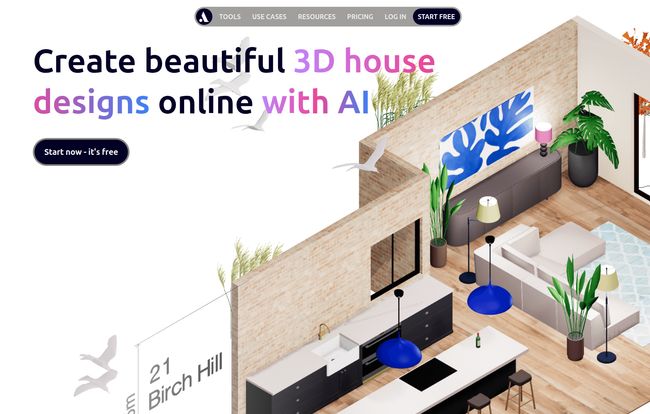
Visit Arcadium
The Features That Actually Matter
Plenty of tools have a long list of features. But which ones make a real difference in your workflow? For me, a few things in Arcadium stood out.
The AI Visualization Magic
Okay, this is the showstopper. Once you have your basic 3D model, you can hit the AI button and tell it what you want. “Make it a photorealistic modern apartment at sunset.” “Turn this into a watercolor sketch.” “Show me this room in a Japandi style.”
A few moments later, you get a handful of AI-generated images that are often stunning. They’re not just sterile renders; they have mood and style. This is an absolute game-changer for presenting ideas to clients or just figuring out the vibe you’re going for. It bridges the gap between a basic 3D model and a final, emotive design concept. It's a bit like having an army of talented concept artists on call, 24/7.
Collaboration and Sharing in the Cloud
I can’t tell you how many times I’ve tried to email a huge 3D file to a colleague, only to have it bounce back. Arcadium is entirely cloud-based. You just send a URL. That’s it. Your collaborator can open it, view it, and if you give them permission, even edit it right alongside you. This is how modern software should work. No exporting, no file versions, no fuss. You can also share the 2D floor plans and elevations directly with a link, which is brilliant for contractors or real estate listings.
Parametric Components (The 'Smart' Blocks)
This sounds technical, but it’s super simple in practice. The doors, windows, and stairs in Arcadium are “parametric.” This means they’re smart. If you make a wall taller, the doors and windows stay put. If you need a staircase to reach a higher floor, you just stretch it, and the number of steps adjusts automatically. This saves an incredible amount of tedious manual adjustment. It keeps the “flow” of creation going without getting bogged down in minutiae.
Who is Arcadium For? (And Who Should Maybe Skip It?)
I’ve seen testimonials from architects, interior designers, and even software engineers who used it for office planning. I think that’s the sweet spot. It's perfect for:
- Interior Designers & Architects: For rapid prototyping and creating beautiful client presentations without the headache of complex rendering software.
- Real Estate Professionals: To quickly mock up a furnished version of an empty property or show potential renovations.
- Hobbyists & Homeowners: If you’re planning a remodel or just want to play around with your home layout, this is probably the most accessible tool on the market.
Who should skip it? If you’re a structural engineer who needs to produce highly detailed, construction-ready blueprints with precise load calculations, this ain’t it. Stick to your industrial-grade CAD software. Arcadium is about creativity and communication, not hardcore engineering specs.
Let's Talk Money: Arcadium Pricing
This is often the dealbreaker, right? But Arcadium’s pricing model is refreshingly straightforward. They have a free tier that is genuinely useful.
| Plan | Cost | What You Get |
|---|---|---|
| Free | €0 / month | Model furniture library, 2 free projects, Single editor, Max 100 objects per project. |
| Pro | €12 / month (billed yearly) | Unlimited projects, Unlimited objects, 50 AI images per month (beta), Multiple editors, 1GB storage. |
Honestly, the free plan is more than enough to get your feet wet and even complete a small project or two. The 100-object limit is the main constraint, but for a single room, it’s manageable. The Pro plan at €12 a month is a no-brainer for any professional. The unlimited projects and, more importantly, the AI image credits make it incredibly valuable.
The Good, The Bad, and The AI-Generated
No tool is perfect. After spending a good bit of time with it, here's my balanced take.
What I Loved
The speed is the biggest win. The learning curve is practically a flat line. I love the AI visualizations and the dead-simple sharing. It makes the whole process of 3D design feel less like work and more like play. The whole thing feels lightweight and responsive because it’s running in a browser.
A Few Caveats
It's an online tool, so if your internet connection goes down, so does your productivity. That's just the nature of the beast. The free plan's limits, especially the 2-project cap, mean you’ll hit a wall pretty quickly if you use it regularly. Also, while the object library is large, you might not find that one perfect mid-century modern armchair you’re looking for. The Pro plan allows importing custom models, which helps, but it’s something to be aware of.
Arcadium vs. The Old Guard
How does it stack up against something like SketchUp? Well, SketchUp is arguably more powerful. It has a massive extension library and can be used for much more detailed modeling. But it also has a steeper learning curve and can feel clunky for quick ideation. Arcadium is to SketchUp what Google Docs is to Microsoft Word. One is built for speed, collaboration, and accessibility; the other is a feature-rich powerhouse that can sometimes get in its own way. For 90% of the initial design tasks, I find myself wanting the speed of Arcadium.
The Bottom Line: Is Arcadium Worth Your Time?
Yes. Unreservedly, yes. For professionals, it’s a powerful new tool in your arsenal for the early stages of a project. For hobbyists, it’s the first 3D design tool I can recommend without a laundry list of warnings. It democratizes 3D visualization, taking it out of the hands of only the most dedicated specialists and giving it to anyone with an idea.
It’s not going to replace your other software entirely, but it will absolutely change how you start a project. It’s fast, fun, and the AI features feel like a glimpse into the future of creative work. Go try the free version. You've got nothing to lose, and you might just find yourself enjoying 3D modeling for the first time.
Frequently Asked Questions
- Do I need to be an architect or designer to use Arcadium?
- Absolutely not! It's designed to be intuitive for everyone. If you can use basic apps on a computer, you can use Arcadium. The Minecraft-like interface makes it very beginner-friendly.
- Can I use Arcadium on my iPad or tablet?
- As it's a browser-based tool, it should work on any device with a modern web browser like Chrome or Safari. However, for design work, using a mouse and a larger screen on a desktop or laptop is generally a much better experience.
- What file formats can I import or export?
- The platform is primarily focused on its own ecosystem for collaboration via URL. The Pro plan allows for importing custom 3D models. For exporting, you can share links to the live model or download the AI-generated images and 2D plans as standard image files (like PNG or JPG).
- How good are the AI visualizations, really?
- They are surprisingly good! They're perfect for mood boards and concept presentations. They might not always be 100% architecturally perfect in every tiny detail, but for conveying a style, a mood, and a color palette, they are incredibly effective and fast.
- Is my data safe in the cloud?
- Arcadium uses cloud-based storage, similar to services like Google Drive or Dropbox. This means your projects are saved automatically and accessible from anywhere. As with any cloud service, it's reliant on the company's security measures, which are typically robust for modern web applications.
Conclusion
Look, the digital tool space is crowded. Every week there's a new app that promises the world. Most of them are just noise. Arcadium, however, is a signal. It’s a smart, focused tool that solves a real, persistent problem: making 3D design accessible and fast. It removes friction and replaces it with creativity. And in my book, that's a massive win.
